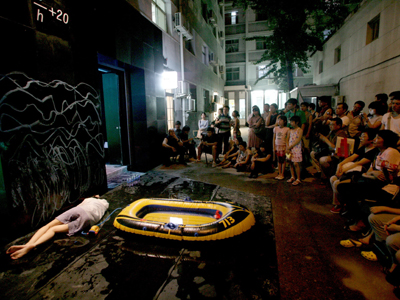 |
Large Medium Small |

Not far from the theater, a group of 20-somethings wearing shorts and T-shirts drank beer in a cobblestone courtyard in front of another theater converted from an early 19th-century building. Two performers were about to step onstage in an experimental drama.
The same night, on the east side of the city, a group of people are tapping their feet and clapping their hands to the impromptu tunes of saxophones and piano at one of the nine theaters of Chaoyang Cultural Center.
The city’s music scene is booming and more venues are popping up, with events’ organizers and venues’ planners playing the role of matchmaker, pairing musicians and art performers with audiences.
“The performance market is flourishing and growing with so much diversity. Fans know what they want and where to find a place for their special likes,” says Zhang Xinyuan, the spokesman of Chaoyang Cultural Center, which is home to many of the capital’s cultural events, such as dance, drama, movies and other art performances.
“We opened the jazz hall this summer especially to cater to fans who love jazz and swing dance music. With bands and jazz artists from China and foreign countries, fans can find traditional jazz music as well as electro-jazz blending with rock and other experimental music elements here.”
In the past few years, Beijing has seen the appearance of lots of performance venues, such as Starlive, D22 and Mao Livehouse along with a wide assortment of bars and clubs. Live shows by a wide range of performers, from western big-name artists and bands such as Sonic Youth and James Blunt, to Chinese established musicians such as Cui Jian and Xu Wei, to some of the most innovative music by Chinese bands such as Carsick Cars, Queen Sea Big Shark, have been staged in the city.
“The music scene here is as good as those in other big cities like New York or Berlin. Some venues mix different music styles together, such as alternative rock, jazz, folk music and electro music,” Zhang says. “With a clearer division of the venue functions, new performance places like our jazz-themed Ao Theater have targeted audiences with particular needs. And bands can better communicate with fans who know them and their music.”
The Beijing folksinger Lao Lang agrees. “Beijing is my hometown and I have seen the music scene growing here for years. Fans are getting mature and professional. They know your music so well that they want something more and special,” he says. “I get the impression that people really just want to enjoy good live music.”
Lao Lang performed on the opening night of the folk music theater at the red-ceilinged Ruby Theater. Located inside Fangjia Hutong, folk music performances will be staged regularly.
“If a folk singer, no matter established or a new face, wants to fully express himself to the listeners, he needs to have more opportunities to stand on the stage with his guitar,” Lao Lang says.
Mako, another new art performance venue in Beijing, located outside the East Third Ring Road in Chaoyang district, is home to two art forms in particular. Audiences can either watch rock bands’ on the first floor or watch traditional crosstalk on the second floor.
“Beijing is a city of various musicians and artists. They need stages,” says Yi Chi, the manager of Mako, which has a regulars show every night.
On the second floor of Mako, which is also converted from an old factory complex, the high-ceiling room is decorated with traditional Chinese paintings, porcelain and teapot. It offers a proper atmosphere for audiences to enjoy old Beijing culture. It contrasts sharply with the tattoo posters and bars on the first floor.
“You can wake up one morning and decide what to see tonight with a clear target place,” Yi says.
And the city’s attraction for the arts goes well beyond music. Labyrinth, an installment art performance presented by Company Styx from France, was performed in a theater at 798 art district this May. And the whole theater was changed into a real labyrinth, inviting the visitors to participate by walking through and getting lost within the stage settings.
According to the theater performance organizer, the theater, Centre d’art Au Nom de la Rose, is ideal for installment art performances. And another installment art experience will be introduced to audiences this September, with a real submarine installed in the theater.
“One thing that makes Beijing’s theaters and art venues grow so fast is that people are eager to see more,” Zhang says. “Like having dinner at different restaurants, it is both haunting and stimulating for those savvy audiences to enjoy the shows catering to their special appetites.”